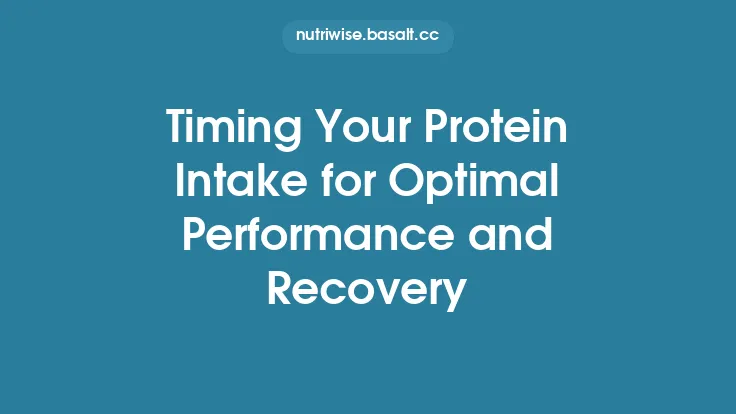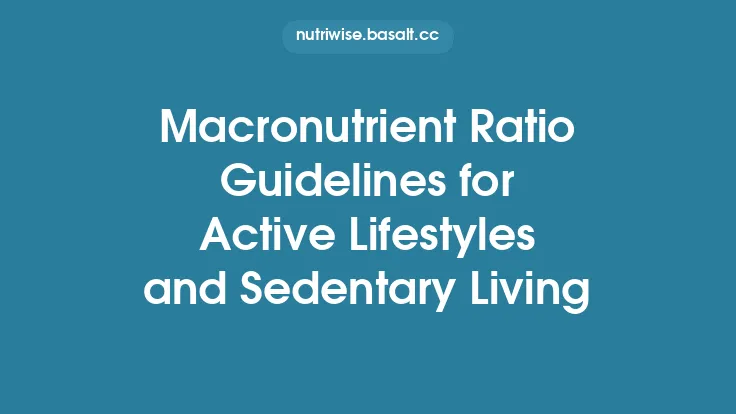When it comes to maximizing both performance during a workout and the speed of recovery afterward, the composition of the meals you consume around your training session can be just as important as the training itself. While overall daily macronutrient intake sets the foundation for health and body composition, the specific balance of carbohydrates, protein, and fat consumed in the hours before and after exercise directly influences energy availability, muscle protein synthesis, glycogen restoration, and hormonal responses. By aligning macro intake with the physiological demands of the activity you’re about to perform—and the repair processes that follow—you can enhance power output, delay fatigue, and accelerate the rebuilding of muscle tissue. The following sections break down the science behind pre‑ and post‑exercise nutrition, outline evidence‑based guidelines for macro distribution, and provide practical tools for implementing these strategies in real‑world training schedules.
Understanding the Metabolic Demands of Exercise
Exercise imposes distinct metabolic stresses that vary by intensity, duration, and modality (e.g., resistance vs. endurance). During high‑intensity, short‑duration efforts (sprints, heavy lifting), the body relies heavily on phosphocreatine and anaerobic glycolysis, depleting muscle glycogen rapidly and generating a surge of lactate. In contrast, prolonged moderate‑intensity activities (long‑distance running, cycling) depend more on aerobic oxidation of both carbohydrate and fat stores.
Two key metabolic pathways dictate nutrient needs around training:
- Glycogen Utilization and Resynthesis – Muscle glycogen is the primary fuel for moderate‑to‑high‑intensity work. Depletion impairs performance, while rapid resynthesis post‑exercise restores the capacity for subsequent sessions.
- Muscle Protein Turnover – Resistance training stimulates muscle protein breakdown (MPB) and, when paired with adequate amino acids, promotes muscle protein synthesis (MPS). The net balance of MPS over MPB determines whether muscle hypertrophy, maintenance, or loss occurs.
Balancing macro intake pre‑ and post‑exercise therefore hinges on supplying sufficient carbohydrate to fuel and replenish glycogen, and enough high‑quality protein to support MPS, while considering the role of dietary fat in hormone regulation and satiety.
Pre‑Exercise Macronutrient Strategies
Carbohydrate Considerations Before Workouts
Carbohydrates consumed 1–4 hours before training serve two primary purposes: topping off muscle glycogen stores and maintaining blood glucose during the session. The optimal amount depends on the anticipated intensity and duration:
| Exercise Type | Recommended Carb Intake (g/kg body weight) | Timing |
|---|---|---|
| Light (<45 min, low intensity) | 0.5–1.0 | 2–3 h before |
| Moderate (45–90 min, mixed intensity) | 1.0–1.5 | 2–3 h before |
| High‑intensity/long (>90 min) | 1.5–2.0 | 3–4 h before, plus a small 15–30 g top‑up 30 min prior if needed |
Complex carbohydrates (e.g., oatmeal, whole‑grain breads, sweet potatoes) are preferred for meals consumed >2 h pre‑exercise because they provide a steady release of glucose without causing gastrointestinal distress. Simpler carbs (e.g., fruit, sports drinks) can be used as a rapid “top‑up” closer to the start of a long or very intense session.
Protein Provision Pre‑Exercise
Consuming protein before training can prime the amino acid pool, attenuate MPB during exercise, and enhance the anabolic response afterward. Research indicates that 0.2–0.3 g protein per kilogram body weight ingested 1–3 h before activity maximizes MPS without compromising digestion.
Key points for pre‑exercise protein:
- Leucine‑rich sources (whey, soy, dairy, lean meats) are most effective at stimulating the mTOR pathway.
- Timing matters less than total daily intake, but a pre‑workout dose ensures elevated plasma amino acids during and immediately after the session.
- Combination with carbs improves insulin response, which further reduces MPB.
Fat Role in Pre‑Exercise Nutrition
While dietary fat slows gastric emptying, a modest amount (≈0.3–0.5 g/kg) included in a pre‑exercise meal 2–3 h before training does not impair performance and can provide a sustained energy source for low‑to‑moderate‑intensity endurance work. Fat is especially valuable for athletes training in a fasted state who need to avoid excessive carbohydrate spikes that could trigger hypoglycemia later.
However, high‑fat meals within 1 h of exercise are generally discouraged because they may cause gastrointestinal discomfort and delay carbohydrate absorption.
Practical Pre‑Workout Meal Planning
A balanced pre‑exercise meal (2–3 h before) might look like:
- Carbohydrate: 40–60 % of total calories (e.g., 1.0 g/kg of oats or brown rice)
- Protein: 20–30 % (e.g., 0.25 g/kg of Greek yogurt or a plant‑based protein shake)
- Fat: 15–20 % (e.g., a handful of nuts or a drizzle of olive oil)
For athletes with limited time, a smaller snack 30–60 min prior—such as a banana with a tablespoon of nut butter (≈15 g carbs, 5 g protein, 5 g fat)—can provide a quick energy boost without overloading the digestive system.
Post‑Exercise Recovery: Macro Priorities
Carbohydrate Replenishment After Training
The post‑exercise window (often referred to as the “anabolic window”) is a period of heightened insulin sensitivity lasting roughly 2 hours after cessation of activity. During this time, muscles are primed to uptake glucose and store it as glycogen. The recommended carbohydrate intake for optimal glycogen resynthesis is:
- 0.9–1.2 g/kg body weight per hour for the first 4 hours post‑exercise (e.g., 70 kg athlete → 63–84 g per hour)
Higher rates (up to 1.5 g/kg/h) may be necessary for elite endurance athletes or those with multiple daily sessions. Combining carbs with protein (see next section) further enhances glycogen storage by stimulating insulin release.
Protein Synthesis and Post‑Workout Protein
To capitalize on the elevated MPS response, ingest 0.25–0.40 g protein per kilogram body weight within 30–60 minutes after training. This dose maximally stimulates the mTOR pathway when paired with sufficient leucine (≈2–3 g). For a 70 kg individual, this translates to 18–28 g of high‑quality protein.
Key considerations:
- Rapidly digestible proteins (whey, soy isolate) are preferred immediately post‑exercise because they raise plasma amino acid concentrations quickly.
- Complete amino acid profile is essential; if using plant‑based sources, ensure a blend that provides all essential amino acids.
- Repeated dosing (e.g., 20 g every 3 h) over the subsequent 24 h can sustain MPS for prolonged recovery.
Incorporating Fats in the Post‑Exercise Window
Contrary to older dogma that fat should be avoided post‑workout, moderate fat intake does not blunt glycogen resynthesis or MPS when protein and carbohydrate are adequately supplied. Including 0.2–0.3 g/kg of healthy fats (e.g., avocado, nuts, olive oil) can aid in:
- Hormone production (testosterone, cortisol regulation) crucial for adaptation.
- Satiety, helping athletes meet caloric goals without overeating later.
- Micronutrient absorption (fat‑soluble vitamins A, D, E, K) that support recovery.
The key is to keep fat proportion moderate (≈15–20 % of the post‑exercise meal) to avoid delaying gastric emptying.
Timing and Quantity: Evidence‑Based Recommendations
| Phase | Carbohydrate (g/kg) | Protein (g/kg) | Fat (g/kg) | Suggested Timing |
|---|---|---|---|---|
| Pre‑Exercise (2–3 h) | 1.0–1.5 | 0.2–0.3 | 0.2–0.3 | Single balanced meal |
| Pre‑Exercise (≤1 h) | 0.3–0.5 (simple carbs) | 0.1–0.2 | ≤0.1 | Small snack |
| Post‑Exercise (0–2 h) | 0.9–1.2 per hour | 0.25–0.40 (total) | 0.2–0.3 | Immediate recovery meal |
| Post‑Exercise (2–4 h) | Continue carbs if glycogen not restored | Additional 0.2 g/kg protein if needed | Moderate | Follow‑up meal/snack |
These ranges are adaptable based on individual factors such as body composition goals, training frequency, and metabolic health. Athletes should monitor performance metrics (e.g., time‑to‑exhaustion, strength output) and recovery markers (e.g., perceived soreness, muscle glycogen via muscle biopsy or non‑invasive imaging) to fine‑tune their macro timing.
Special Populations and Training Modalities
- Endurance Ultra‑Athletes: Require higher carbohydrate loads (up to 1.5 g/kg/h) and may benefit from multiple carbohydrate sources (glucose + fructose) to maximize intestinal absorption.
- Strength‑Focused Lifters: Emphasize protein (0.4 g/kg post‑session) and moderate carbs (0.8 g/kg) to support glycogen without excessive caloric surplus.
- Fasted Training Practitioners: May rely on intra‑session carbohydrate (e.g., 30–60 g glucose polymer) and post‑exercise protein to compensate for the lack of pre‑exercise fuel.
- Vegetarian/Vegan Athletes: Need to ensure adequate leucine (≈2.5 g per post‑workout meal) through soy, pea, or rice protein blends, and may require slightly higher total protein (≈1.8 g/kg) to achieve comparable MPS.
Common Misconceptions and Pitfalls
- “The anabolic window closes after 30 minutes.”
Research shows the heightened insulin sensitivity and MPS response can persist up to 2 hours, especially when the post‑exercise meal contains both carbs and protein.
- “High‑fat meals always impair recovery.”
Moderate fat does not hinder glycogen resynthesis if carbs and protein are sufficient; the issue arises only when fat displaces those critical nutrients.
- “All carbs are equal pre‑workout.”
Low‑glycemic, fiber‑rich carbs are ideal for meals >2 h before exercise, while simple sugars are better for rapid top‑ups <1 h prior.
- “Protein alone is enough post‑exercise.”
Without carbs, insulin response is blunted, slowing glycogen restoration and potentially limiting MPS in the presence of high MPB.
- “You must eat a full meal immediately after training.”
A 20–30 g protein shake with 30–50 g fast‑acting carbs can be sufficient, especially when followed by a balanced meal within the next 2 hours.
Putting It All Together: Sample Pre‑ and Post‑Exercise Meals
Pre‑Workout (2 h before a 90‑minute interval session, 70 kg athlete)
- 80 g cooked quinoa (≈1.1 g/kg carbs)
- 150 g grilled chicken breast (≈0.3 g/kg protein)
- 1 tbsp olive oil (≈0.2 g/kg fat)
- Steamed broccoli (fiber, micronutrients)
Pre‑Workout Snack (30 min before a heavy squat day)
- 1 medium banana (≈30 g carbs)
- 15 g almond butter (≈2 g protein, 5 g fat)
Post‑Workout (within 30 min after a 60‑minute strength session)
- Whey protein shake: 30 g whey isolate (≈0.43 g/kg protein) mixed with 250 ml skim milk (≈12 g carbs)
- 1 cup cooked white rice (≈0.9 g/kg carbs)
- 100 g baked salmon (≈0.25 g/kg protein, 0.2 g/kg fat)
- ½ avocado (≈0.15 g/kg fat)
Follow‑Up Meal (2 h later)
- Whole‑grain wrap with hummus, turkey slices, mixed greens, and a drizzle of tahini – providing additional carbs, protein, and healthy fats to complete daily macro goals.
By aligning macro intake with the specific metabolic demands of the workout—delivering readily available carbohydrate fuel before activity, supplying high‑quality protein to curb muscle breakdown, and replenishing glycogen and stimulating MPS afterward—athletes can achieve more consistent performance gains and faster recovery. The principles outlined here are adaptable across sports, training levels, and dietary preferences, offering a robust framework for anyone seeking to fine‑tune their nutrition around exercise.





